
Boating Basics Online is reader-supported. When you buy via our links, we may earn a commission at no cost to you. Learn more

How Much Does It Cost to Shrink Wrap a Boat? – Updated in 2023
Written by J. Harvey / Fact checked by S. Numbers
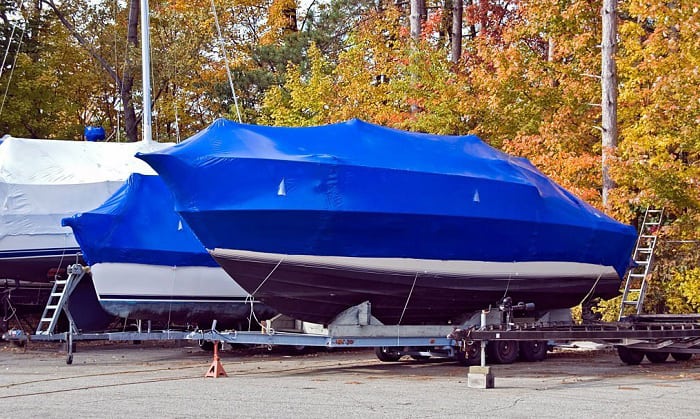
Shrink-wrapping is an important measure for any boat going into storage. However, it is known to be an expensive option. Just how much does it cost to shrink wrap a boat?
The cost changes depending on the length and dimensions of a boat, from an estimated $8 to $25 per foot. Let’s take a look at how this estimate changes and a brief overview of what shrink-wrapping entails.
Keep reading to learn more.
Table of Contents
1. Factors affecting price
2. professional services, boat shrink-wrapping, how a boat is shrink-wrapped, 1. is it necessary to shrink-wrap a boat, 2. are there alternatives to shrink-wrapping a boat, 3. what problems may arise from improper shrink-wrapping of a boat, 4. should i consider shrink-wrapping a boat myself, shrink wrap boat cost.
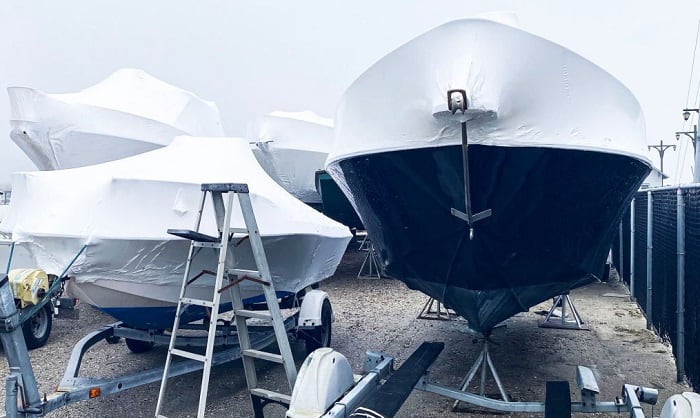
The cost of shrink wrapping a boat will vary based on the length and dimensions of the boat. Even when two boats have similar lengths, it is still likely that the total cost of shrink-wrapping would differ for each.
On average, boat shrink wrap cost per foot will be around $8 to $25. The type of boat you have will also affect prices, with an increase of up to $3 per foot if you leave the mast raised on a sailboat.
Other factors affect shrink wrap prices, and the ones that usually matter the most are the height of the rail, the width, and height of the boat itself. The effect of the boat’s dimensions on price should be somewhat easy to see since there will be a larger surface to wrap.
The rail affects the price because ideally, the boat is shrink-wrapped up to a certain point of the hull with the rail included.
Another point that greatly affects the price is the quality of materials. The quality of plastic may increase the average price by as much as $3 per foot, and the choice of material to help tie down the shrink wrap can also add to cost.
The durability of the shrink wrap will vary greatly depending on material quality, with cheap wrapping tearing easily.
The fee for hiring a professional also greatly increases boat shrink wrap prices. Since shrink-wrapping a boat involves using heat to apply the wrap , it makes sense to have someone who has a vast amount of experience performing this sort of task, and that sort of professional expertise does not come cheap.
Choosing to be stingy and ending up with a damaged boat is not something any boat owner would want to experience.
Various other services may be necessary when shrink-wrapping a boat, and each of these services will incur an additional fee. Depending on each boat, installations such as lights or antennas may need to be removed or adjusted.
Shrink-wrap is made of a plastic material, most commonly polyethylene, that resists UV and is designed to be weather-resistant. It is used in a variety of ways and is used to protect a boat when it is brought in for storage, for winterization, or if it is expected to be unused for long periods.
Pros and Cons of Boat Shrink-wrap
- Offers the best protection for boats
- Effectively seals out dirt and weather elements
- The least amount of maintenance is necessary
- Expensive compared to other options
- Prone to problems if not used correctly
The first step is to clean and dry a boat entirely before the shrink-wrapping process, including any storage space or drawers. It’s also important to remove any potential source of moisture on board such as personal flotation devices or any item that may have leftover water or moisture.
Any item that may attract insects or pests should also be removed, along with batteries and electronics.
Center support, usually made of wood, should be placed at the center of the boat and padded or carpeted. This support also creates the necessary angle to allow water and snow to easily slide off the shrink-wrap surface.
The shrink-wrap is placed over the boat and should reach up to a certain part of the boat’s hull. It should be well-vented to help prevent any buildup of moisture. This venting is placed in specific key areas.
The shrink-wrap is exposed to heat using a heat gun or a torch to tighten the shrink-wrap on the boat, with any holes patched using shrink-wrap tape.
A cord or tape is used running from one side of the shrink wrap to the other going under the boat. Boat shrink-wrap that has been applied and removed properly may be reused.
Frequently Asked Questions
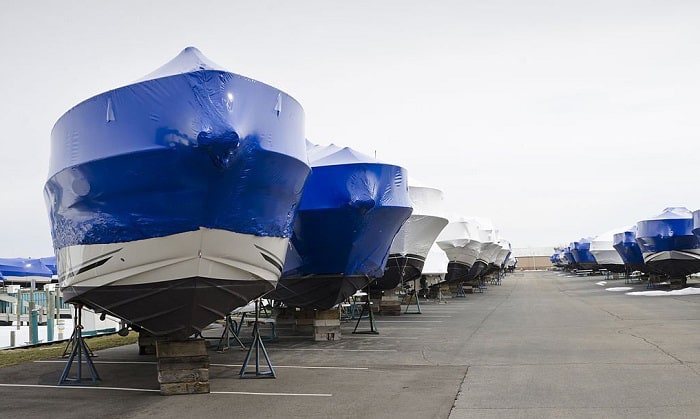
It is not required to use shrink-wrap, but it is important to protect the boat if it will be stored, transported for long distances, or will be unused for a while. There are other options too, but shrink-wrapping is arguably the best way to protect a boat.
The most common alternative to shrink-wrapping a boat is to use a tarp instead. As a cover, a tarp is durable and can effectively shield a boat from dust and weather elements. Its biggest drawback is that it may come off easily and not be able to properly seal the boat, which means you will have to check on it often.
Shrink-wrap that is not properly applied may allow moisture build-up that can cause damage or mildew. It also involves the use of heat, and improper use of this heat may cause damage to a boat.
Other problems include pests or a buildup of water on the boat due to rain or snow.
Only consider doing so if you have experience with shrink-wrapping and you are confident in your skill. As stated above, the damage that may be caused to a boat can be costly.
If your only reason for wanting to do the shrink-wrapping yourself is to bring down the cost, it’s better not to do it since shrink-wrapping tools along with materials will usually cost a lot.
However, if you want to try shrink-wrapping boats, it’s a good idea to start with less expensive boats. Start small and move on to bigger boats as you gain more experience.
You now have a basic understanding of the shrink-wrapping process, including some problems that may arise if it was not done properly.
Don’t forget to share what you’ve learned to anyone asking how much does it cost to shrink wrap a boat. Please leave your comments and suggestions below.
Remember to boat safely.

“My intention from the first day establishing Boating Basics Online is to provide as much help as possible for boaters who want to experience a first safe and convenient trip. So feel free to join us and share your beautiful journeys to the sea!”
Save up to 50% on boat storage
- Boat Storage
Is Boat Shrink Wrapping Worth the Cost in 2023?
Your boat needs protection from the ravages of weather, overland travel, dirt and debris, and UV radiation. Shrink-wrapping is one solution, but it typically comes at an annual expense (and is not an inexpensive one ).
Consider alternatives before taking advantage of the benefits shrink wrapping offers. More cost-effective solutions may be available, depending on your situation. Boat tarps or covered storage options are just two of the many possibilities for boat storage .
But what exactly is shrink-wrapping? And what are the alternatives? What other conditions tilt the decision to one option over another? Read on, and we’ll uncover the vagaries and vicissitudes of the shrink-wrap decision.
Understanding Boat Shrink Wrapping
Shrinkwrapping boats entails covering almost the entire boat — at least slightly below the rub rail (or further down the hull) — with a single sheet of plastic film that, when heated , shrinks to conform tightly to the boat’s contours.
This process provides a taut, impermeable cover for the boat, shielding it from the harmful effects of weather and UV damage. It’s like heat-shrink insulation for electrical wire—but on a much larger scale.
Boats are usually shrink-wrapped for protection:
- During the colder winter months (the time of year when pleasure boats are usually stored out of the water).
- When they are being transported overland
The most commonly used boat shrink-wrap material is low-density polyethylene (LDPE) . Available in rolls of varying lengths and widths, depending on the boat’s dimensions, LDPE is renowned for its durability and protective qualities.
The Shrink Wrapping Process
NOTE: If the boat will be exposed to freezing temperatures, you must “ winterize ” the engine(s) and plumbing before the shrinkwrapping process begins.
Most boating experts agree that shrink wrapping, although plausibly a DIY project, is usually best left to professionals. The difficulty, especially for the DIYer, increases with the size of the boat.
The basic process (not the details) is:
Step #1: Build a Support Grid Made of Poles (Usually 2x4s) and Webbed Strapping
Place the poles at approximately 4’ intervals along the bow-to-stern centerline. Then, attach the strapping to the pole tops, which should run perpendicularly to the rub rail to form a support grid.
The tops of the poles should be higher than the surrounding areas, and the strapping should outline “rectangular-ish” areas.
Step #2: Cut the Shrink Wrap
Cut the correct length of film from the roll, then unfold it and drape it over the grid.
Step #3: Bring Out the Heat Gun
Put on protective gloves and, using a propane-fired heat gun, construct a tunnel-like “hem” in the film, which contains a small diameter line (¼”) all the way around the hull at the height where the wrap should end.
Step #4: Pull the Drawstring Tight
Make several folds of the loose film back over on itself (from top to bottom), and seal the edges with shrink-wrap tape.
- Use the propane heater to heat areas of the film until they shrink.
- After the vessel is covered, Install vents and zippered doors or hatches as needed.
How Neighbor is changing storage
Transparent monthly savings.
Renters save 30-50% on boat storage, on average. No rate hikes.
Keep your boat nearby
Hosts in your neighborhood means that your boat is always close by.
Storage made simple
Don't settle for stone age tech and long contracts. Neighbor makes it easy.
Benefits of Boat Shrink Wrapping
Protection from harsh weather and uv rays.
The excellent protection against harsh weather conditions during winter storage is one of shrinkwrapping’s glowing benefits. The tight fit and impermeable material keeps rain, snow, ice, and wind outside of your boat.
This level of protection is crucial for maintaining the integrity of your boat’s structure and minimizing damage.
A shrink-wrapped boat also means superior UV protection compared to a traditional boat cover , which can help prevent long-term sun damage and fading of the boat’s finish.
Custom Fit and Secure Seal
Shrink wrapping a boat offers a custom fit and secure seal . Minimizing “low spots” in which rainwater or snow can collect is easier than with fabric or tarp covers.
Save up to $1,200/year on boat storage
Potential drawbacks of boat shrink wrapping.
Despite the benefits, there are downside risks to shrink-wrapping your boat. The primary concern is usually the relative cost vs other protective measures.
Cost of Shrink Wrapping
Costs of shrink wrapping will vary greatly depending on the size and type of boat and its location. Average costs range from $8 to $25 (or more) per foot. Additional costs may apply for special configurations or installation of hatches and vents.
If you decide to undertake a DIY shrink-wrapping project, realize that you’ll need to secure the necessary tools, equipment, and materials.
When DIYing, expect to spend at least $900 – $1000 .
Materials alone can cost $300-$400 for a 30’ boat . At this cost, choosing the DIY route may be difficult to justify. Because of the upfront costs, consider a professional boat shrink-wrapping service.
Risks of Shrink Wrapping
Even with a professional service, there’s a risk of damage because of improper installation. During a DIY project, that risk is only magnified. There are several unpleasant side effects your risk depending on what went wrong during the installation:
With a painted boat’s finish, improper shrink wrapping can be damaging. Although most boats are protected with an exterior of “gel coat”, some boats are painted, often with a linear polyurethane paint like AwlGrip or Imron®. In this case, shrink wrapping is usually not recommended for this type of paint.
If your boat is painted, check whether the paint manufacturer recommends against shrink-wrapping
The boat’s exterior finish can be damaged If the installer applies too much heat. These damages may not be “uncovered” until the beginning of the next boating season.
Mold and mildew
If adequate ventilation is not achieved using properly-installed vents , mold and mildew can be a risk factor.
Alternatives to Shrink Wrapping
As with many boating-related decisions, you’ll need to conduct a cost comparison between alternatives. In other words, what are the cost differences between shrink wrapping and paying monthly rent on indoor storage space, for example?
Note that, usually, shrink wrapping usually is performed annually in preparation for winter storage, so it’s considered a recurring cost .
Indoor Storage
Indoor storage , the most secure option for boat protection, is another recurring cost. The primary benefit of indoor storage is that the boat is not exposed to the elements. Confirm that the facility is heated; if not, winterize the engines and the plumbing.
Indoor storage also provides better physical security.
However, indoor storage will be pricier than other alternatives. Costs will vary significantly depending on the locality, the security, and the customer service level. Request detailed pricing information from several facilities before making your decision.
Roughly estimated, you can expect to pay $50/per foot of your boat for indoor or covered boat storage.
Canvas Covers
A canvas cover is considered a one-time cost. It can be used for year-round protection and tends to last longer than the typical length of boat ownership.
A custom cover , which may cost around $1500, is often available to fit specific boat makes and models.
Others are “semi-custom,” made to fit all boats of similar designs and dimensions, typically costing a few hundred dollars. A canvas cover ordinarily has lower long-term costs than shrink wrap but offers less protection.
Determining Whether Boat Shrink Wrapping is Right for You
If you have a large boat (e.g., one that is too large to trailer), and it’s kept outdoors in severe weather, your decision should be biased toward either shrink wrapping or indoor storage. If your boat is too large for indoor storage at a reasonable price, then you should lean toward shrink wrapping. If you have a smaller boat, all the options are open.
Ultimately, the decision to shrink-wrap your boat depends on how much you’re willing to pay for the protection you need. You’ll also want to account for these other factors:
- Your boat’s size
- Its storage location
- Expected effects of wind, rain, and snow and the level of protection you will accept
- Cost compared to alternatives
When evaluating the level of protection your boat needs, check out Neighbor , a peer-to-peer self-storage marketplace where you can find convenient and nearby boat storage options for safe winter storage. Whether you plan to opt for more affordable outdoor boat storage or invest in a luxury indoor storage space, Neighbor has what you’re looking for.

Related Posts
- Boat Ownership
The Different Types of Boat Covers: How to Choose the Right Type
Winter storage for boats: tips and alternatives , how to cover a boat with a tarp.

Justin earns $650/mo on Neighbor. Find out how you can too!
Stay in the loop ↓

How To Shrink Wrap a Sailboat

Last Updated by
Daniel Wade
June 15, 2022
Many boat owners opt for shrink wrapping as a winterizing solution. Here's why you should consider shrink wrapping a sailboat and how it’s done.
Shrink wrapping a sailboat has many pros, including advanced water protection, stability in harsh environments, and customization to each unique sailboat.
The process of shrink wrapping a sailboat begins with creating a frame with straps, then using tape and strategic cuts to secure the plastic wrap to the frame, and finally, the process ends with using a heat gun to weld the plastic’s seams and shrink the cover.
Table of contents
Why Shrink Wrap a Sailboat?
Shrink wrapping is most common in northern parts of the world where freezing is a certainty . Unless you can store your boat inside, you have to cover it for those long months without fine sailing weather.
There are other methods of covering your boat. You could use a large tarp, or pay for a coveted spot at a storage facility. But, for people who want a one-and-done solution, shrink wrapping is the most effective option.
Pros of Shrink Wrapping:
- It’s made of plastic, so it wicks water off the cover’s surface. If installed correctly, then the chance of water getting into the covered area is very slim.
- It’s stable. The shrink wrap covering gets strapped down in multiple areas. The tight fit makes it so it won’t get blown off your boat by strong winds. Also, water won’t pool on the surface of the cover and cause it to collapse.
- It’s cheaper than a permanent boat cover. If you’ve just bought a boat and haven’t invested in a permanent cover, or if you had a cover and now it needs replacing, shrink wrapping is a cheap way to cover your boat for the winter season without much commitment.
- You can customize the cover each winter. Since each shrink wrap is good for one winter, you can configure it differently each year if you need it. For example, if you’re going to take advantage of the winter season to do some needed updates on your boat, you can configure the cover so that you can get under it and still work.
It would be remiss to not mention the cons of shrink-wrapping a sailboat. Though, you can avoid many of the cons by planning for them in advance.
Cons of Shrink Wrapping a Sailboat:
- It makes a lot of plastic waste. As a sailor, you’re probably conscious of the effects your waste has on the ocean. To counteract the plastic waste, make sure to have a plan in place for recycling the cover once the winter season is over.
- Costs are reoccurring. If you choose to use a shrink wrap cover for your sailboat every year, the costs can add up. But, it’s the most effective way of keeping your boat dry during winter. It’s also a good option for boat-owners who are still searching for their permanent solution.
- Installation is tricky. If you’re not experienced with the tools needed (such as a blow torch) for installing a shrink wrap, you probably want to hire professionals. This ensures it’s installed correctly, but it is an additional cost.
- Ventilation is an issue. If water gets trapped within the shrink wrap, it could cause mildew or mold. So, you need to install vents in areas where water won’t get in but that encourages airflow.
Ultimately, when it comes to deciding whether or not to shrink wrap a sailboat, each boat owner’s unique circumstances matter more than anything. Your specific location, storage options, and budget will help you to decide what your best option is.
How to Shrink Wrap a Sailboat
Shrink wrapping a sailboat has many steps that have a specific order and must be done right to ensure a watertight seal. Before beginning the process, decide if you want to cover the sailboat with the mast up or down.
The location you’re storing the boat will matter. Also, if you plan on working on the boat during the winter season, you’ll want to make sure you have enough headroom to get on the deck.
By wrapping the boat with the mast up, you can decide how much deck room you’ll have. On the other hand, if you keep the mast down, you won’t be able to access the sailboat deck.
Steps to Shrink Wrap a Sailboat
- Prepare the sailboat’s interior and exterior. If your boat is currently in the water, it must be dry-docked. Clean the inside of your boat and make sure there’s no excess moisture anywhere. Open the hatches and drain plug so any water still in the boat can drain or air out before you wrap it.
- Start on the supports. The supports are straps that run from the mast, or center, of the boat and to the bow and the stern, and then down the center and around the boat. The more supports you place on the deck, the more sturdy your shrink wrap cover will be. Make sure to tighten the straps well enough, but not too tight because they might bend the boat railing.
- If you’re shrink wrapping the boat with the mast down, you’ll need to use wooden supports, or basic 2 by 4 planks, to make sure the wrap holds a structure In the center so water and snow can easily slide off and not build up.
- Secure the hull strap horizontally around the length of the boat. It’s a good idea to use the waterline as a guide . Tighten this strap so it doesn’t slide down.
- Measure the plastic wrap for your boat. It will be in two parts, one for the bow half of the boat and one for the stern half. Make sure to give yourself 1-2 ft of excess plastic on each side to form a weld and to wrap around the hull strap that is already secured horizontally across the waterline.
- Once you have the plastic measured and cut, roll it up and bring it on the deck. Cut two slits in the plastic where it will wrap around the mast or the wooden frame. Then, use tape to secure and watertight seal the plastic to the mast. Do this with both halves of the plastic cover. Make cuts in the plastic for the stays and secure the plastic with more tape. Remember, a watertight seal is necessary to keep water out during the winter months.
- After you secure the plastic on the deck, move to the hull strap. You should have at least 1 foot of extra plastic to wrap around the strap. Again, secure the plastic with tape.
- When you have the two plastic sheets secured, you can begin welding the plastic. (This is the part where many people prefer a professional.) You’ll need a special heat gun and arm attachment for this. Lightly heat the seams where the two plastic sheets meet and weld the plastic together.
- After welding the seams together, tape over them again to ensure maximum durability.
- Complete the process by lightly blowing heat over the entire plastic cover, thus shrinking it and creating an airtight seal. Be careful not to heat the plastic too much. You just want to heat it enough so it forms a tight wrapping around your boat.
DIY Shrink Wrapping vs. Hiring a Professional
Most sailors are comfortable with a DIY project here and there—it’s part of boat ownership. But shrink wrapping a boat requires special tools and specialized skills so you don’t damage the boat.
If you’re confident with the process, doing it yourself is a cost-efficient option. But, hiring a professional is easy. Most marinas and boatyards have people experienced with shrink wrapping boats.
Hiring a professional has many benefits such as insurance (they are working with a blow torch near your boat after all), experience, and help. Also, they’ll discard the plastic after the winter season. Many boatyards have a recycling source specifically for shrink wrapping.
Boatyards and marinas typically charge by the foot for shrink wrapping services. Sailboats may end up costing more because of the amount of hardware that needs securing and wrapping.
There are also shrink-wrap services that will come to your boat, which is a good option for people who don’t store their boat in a yard or marina.
Expect to pay $25 to $60 per foot to shrink wrap a sailboat. Of course, this price can range dramatically based on your location and the competition.
Should You Shrink Wrap Your Sailboat?
The answer depends entirely on your situation. If you store your boat outside in a climate that often has snow, rain, and freezing temperatures, shrink wrapping is a sure way to keep moisture from entering the hull and causing damage.
If you’ve recently purchased a sailboat and haven’t decided on a reusable boat cover (which can be a large upfront cost), shrink wrapping is a good temporary solution for when it comes time to winterize .
On the other hand, if you live in a climate that doesn’t freeze, or if you’re looking for a more budget-friendly option, shrink wrapping a sailboat might not be the right solution for you.
Related Articles
I've personally had thousands of questions about sailing and sailboats over the years. As I learn and experience sailing, and the community, I share the answers that work and make sense to me, here on Life of Sailing.
by this author
Most Recent

What Does "Sailing By The Lee" Mean?
October 3, 2023

The Best Sailing Schools And Programs: Reviews & Ratings
September 26, 2023
Important Legal Info
Lifeofsailing.com is a participant in the Amazon Services LLC Associates Program, an affiliate advertising program designed to provide a means for sites to earn advertising fees by advertising and linking to Amazon. This site also participates in other affiliate programs and is compensated for referring traffic and business to these companies.
Similar Posts

How To Choose The Right Sailing Instructor
August 16, 2023

Cost To Sail Around The World
May 16, 2023

Small Sailboat Sizes: A Complete Guide
October 30, 2022
Popular Posts

Best Liveaboard Catamaran Sailboats
December 28, 2023

Can a Novice Sail Around the World?
Elizabeth O'Malley

4 Best Electric Outboard Motors

How Long Did It Take The Vikings To Sail To England?

10 Best Sailboat Brands (And Why)
December 20, 2023


7 Best Places To Liveaboard A Sailboat
Get the best sailing content.
Top Rated Posts
Lifeofsailing.com is a participant in the Amazon Services LLC Associates Program, an affiliate advertising program designed to provide a means for sites to earn advertising fees by advertising and linking to Amazon. This site also participates in other affiliate programs and is compensated for referring traffic and business to these companies. (866) 342-SAIL
© 2024 Life of Sailing Email: [email protected] Address: 11816 Inwood Rd #3024 Dallas, TX 75244 Disclaimer Privacy Policy
- Hybrids & EVs
- Motorsports
- Tips, Tricks & Trends
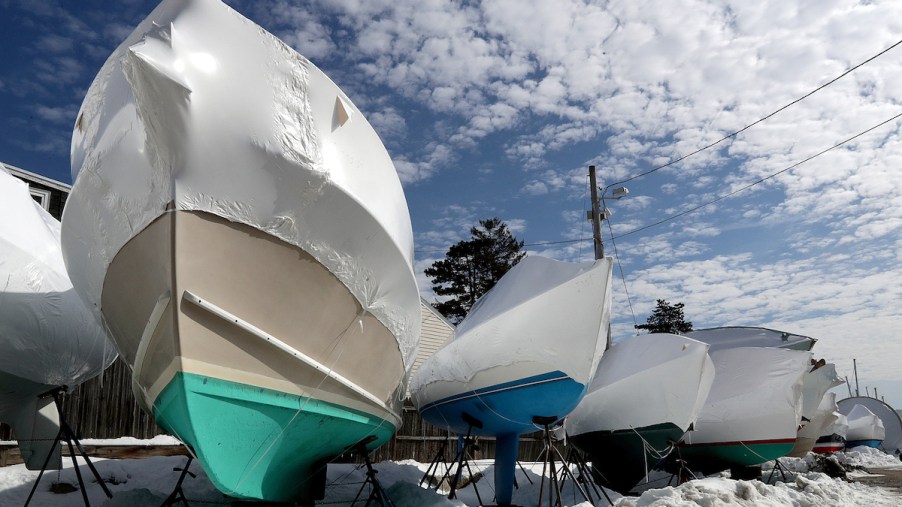
How Much Does It Cost To Shrink Wrap a Boat?
Winter is already breathing down our necks. Unless you’re one of the lucky few who live in a region where it never freezes and you’re able to boat throughout the winter months, now is the time to haul your boat out of the water. It’s also time to think about winterizing your boat.
If you’re one of the many people who entered into boat ownership during 2020 , prepping your boat for the winter is a new experience. There are many costs associated with insuring your boat makes it through the cold season in tip-top condition. One of the things you’ll have to consider is the cost of having your boat encased in shrink wrap.
Should you shrink-wrap your boat?
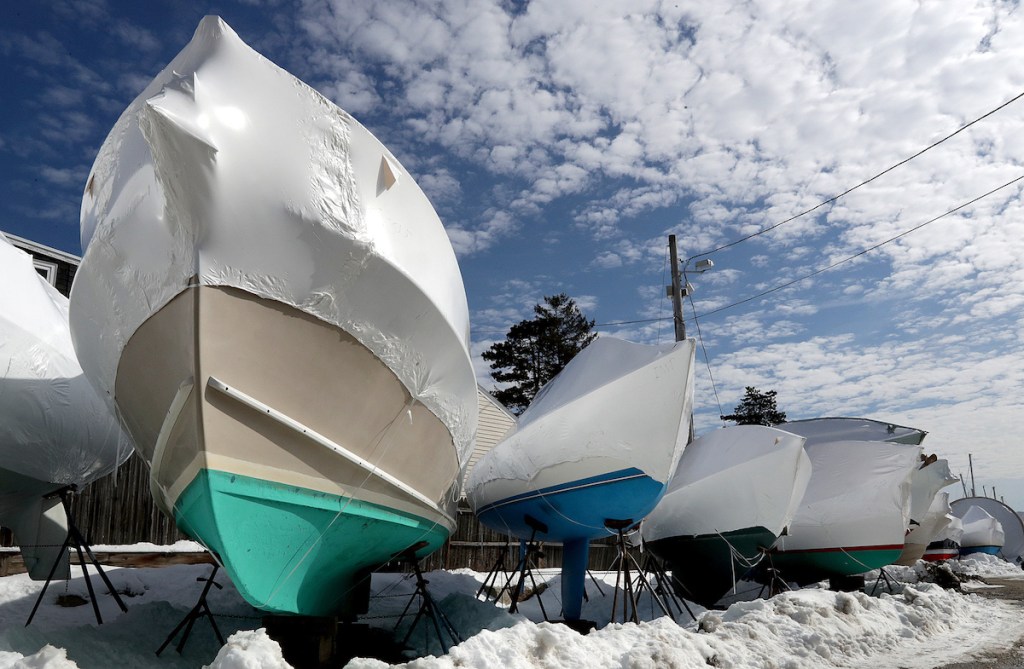
Having your boat encased in shrink wrap is a major expense. The estimate often makes boat owners question whether it’s necessary. Some boat owners can avoid this particular step when they winterize their boat, but they are few and far between. More than one boat owner has decided that they could forgo having their boat shrink-wrapped by simply using their boat cover. Most regretted the decision.
The shrink wrap that is used to encase your boat, is extremely tight, The tightness of the material prevents ice from damaging your boat when it is struck by winter weather. Boat covers don’t fit as tightly over the boat. All it takes is one tiny tear or lose spot in the cover and the wind will rip the cover from your boat, exposing it to the elements. If the wind doesn’t disturb the cover, the build-up of snow on the top of the cover will eventually damage your cover and boat. Repairing the damage after simply using a cover during the winter is often expensive.
Unless you’re lucky enough to have an indoor space you can use to store your boat, it’s in your best interest to invest in shrink wrap.
How to shrink wrap your boat
Before your boat is encased in shrink wrap, it needs to be removed from the water and allowed to dry. Smaller boats are often left on their trailer while larger boats are transferred to stabilizing blocks. After the boat has sat in the sun for a few days, the shrink wrap process can begin.
The boat should be in a well-ventilated space so that the fumes associated with the shrink wrapping process can dissipate. Measuring the boat determines how much material is needed to complete the process. Add fourteen inches to both sides.
The fuel line valve is turned off and all remaining fuel is drained from the fuel lines before shrink wrap tape is applied to the fuel vents. Padding is placed over the boat’s corners and sharp edges. The padding is crucial. Without the padding, the shrink wrap would tear as it’s pulled tight over the boat. Support posts and strapping is used to create a frame for the shrink wrap. A perimeter band is wrapped around the boat.
Clean shrink wrap is draped over the entire boat and tucked under the boat’s perimeter band. A heat tool is used on the shrink wrap, securing it to the band. Belly bands are attached to both the edges of the shrink wrap and the boat’s trailer/blocks. The shrink wrap is tucked in tight to the stern. Heat welds the shrink wrap in place. With the perimeter of the shrink wrap in place, heat is applied to the rest of the shrink wrap. Weak points are reinforced with tape. Adhesive vents are attached to the shrink wrap. Once these vents are cut open and properly capped, your boat is ready for winter.
How much does it cost to have your boat encased in shrink wrap?
Having your boat encased in shrink wrap for the winter isn’t cheap. Professional boat shrink wrappers use the boat’s size to determine the final amount . When you have the boat covered by a professional, you should plan on spending $12-25 per square foot. You can save a little money if you do the work yourself .
Do You Have To Winterize Your Outboard Motor?

Buckle up for a New Era of Affordable Horsepower

Why Renting an RV Makes More Sense Than Owning

In-Car GPS Data Could be Used to Improve Traffic Signal Wait Times
Milla Henson
Milla Henson is a contributing writer for MotorBiscuit.

Boat Wrap Cost: A Comprehensive Guide to Pricing and Factors
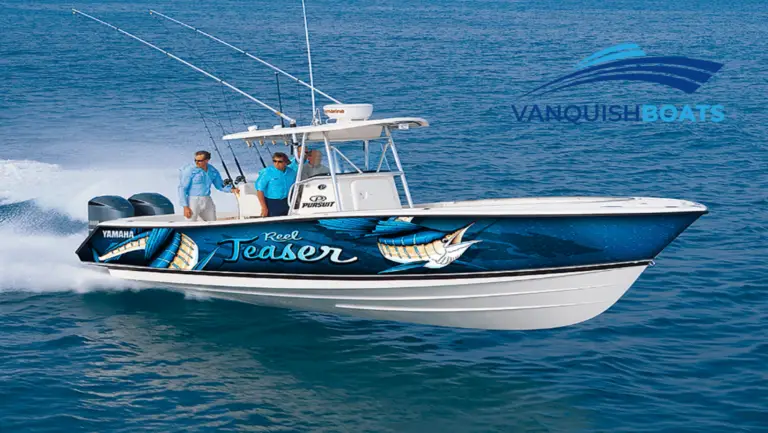
Boat wrap costs can vary widely, ranging from $600 to $3,200, depending on factors such as the size of your boat, the quality of the vinyl wrap, and whether you opt for a partial or full wrap. Partial wraps, which cover only a part of the hull, are generally a more budget-friendly option, while full wraps tend to be more expensive, with prices ranging from $1,400 to $4,100.
As I delved deeper into this topic, I discovered that there is a lot to consider when evaluating boat wrap costs, including the durability and efficiency of the wrap, as well as potential savings from DIY wrapping. I hope this information will be helpful to you as you weigh your options for giving your boat a fresh, eye-catching look.
Table of Contents
Factors influencing boat wrap cost, material used.
The type of material used for the boat wrap is a crucial factor in determining the cost. High-quality vinyl and laminates generally command higher prices. Low-cost options often involve sacrificing the quality, durability, and appearance of the wrap. Remember that quality materials are less likely to fade, peel, or get damaged, ensuring that your investment pays off in the long run.
As you might expect, the size of your boat plays a significant role in the overall cost of a boat wrap. Larger vessels require more materials and labor, which will increase the cost. For example, wrapping a small speedboat would be cheaper than wrapping a yacht. The cost per square foot for materials generally varies from $7 to $10, plus labor fees.
Design Complexity
The intricacy of the wrap design also affects the final cost. Simple and minimalist designs often cost less, as they require fewer materials, time, and effort to apply. On the other hand, complex graphics, custom artwork, and intricate patterns demand more expertise and precision, which can increase the cost. It’s essential to balance your unique design preferences with your budget constraints when choosing the ideal wrap for your boat.
Regional Variations
Geographical factors can also influence the cost of wrapping a boat. Depending on your location, labor fees and material costs might vary significantly. Some areas may have higher wrap installation fees due to increased demand or the availability of skilled professionals. It’s important to research local prices and compare multiple providers in your region to find the most cost-effective and reliable solution.
In summary, the cost of boat wraps depends on various factors, such as the materials used, boat size, design complexity, and regional variations. By understanding these factors and considering them when selecting a boat wrap, you can make an informed decision that suits both your design preferences and budget.
Average Cost of Boat Wraps
As a boat owner, I always want my boat to look great and stand out on the water. One popular method for enhancing a boat’s appearance and protecting it from the elements is wrapping it in high-quality vinyl. When it comes to wrapping your boat, understanding the average cost involved is important as it helps in making the right decision.
From my research, I have discovered that the cost of a boat wrap can vary greatly depending on several factors such as the size of the boat, the type of wrap material, and the quality of the wrap. On average, a full wrap can cost anywhere from $1,500 to $15,000 or more. Of course, premium quality wraps tend to be more expensive, but they offer better protection against the elements and usually last longer.
If you are considering a partial wrap, which only covers a part of the hull, the expense will typically be lower. Partial wraps can range from $600 to $3,200. However, full wraps that cover the entire hull can cost anywhere from $1,400 to $4,100.
When selecting a wrap for my boat, I always consider factors such as the boat length, wrap quality, and any custom graphics or designs I might want to include. It’s important to remember that customizations will likely add to the overall cost.
In summary, the average cost of boat wraps can vary greatly depending on several factors, including the size of your boat, the type of wrap material, and any customizations you may want. No matter what your budget or preferences may be, a vinyl boat wrap offers a great way to give your vessel a fresh look and protect it from the elements.
Cost Breakdown of Boat Wraps
As a boat owner, understanding the costs involved in getting a boat wrap is crucial. In this section, I will provide a cost breakdown of boat wraps, covering the wrap material, design and layout, and installation cost.
The Wrap Material
The primary factor influencing the cost of a boat wrap is the material used. Most boat wraps are made from high-quality vinyl, which is renowned for its durability and aesthetics. The cost of vinyl boat wraps is typically between $7-$10 per square foot for the material. Here’s a breakdown:
Please note that these are approximate costs based on estimates and can vary depending on the specific vinyl material chosen.
Design and Layout
The complexity and uniqueness of the design or layout can greatly impact the final cost of a boat wrap. Basic designs will be more affordable, whereas customized designs, including graphics or logos, will require more effort and time. Here’s a quick comparison of the cost between basic and complex designs:
- Basic design: $50-$75 per linear foot
- Complex design: $75 and up per linear foot
Keep in mind that a designer’s time and expertise may be needed for custom designs, increasing the cost.
Installation Cost
Lastly, the installation cost is a significant aspect of the boat wrap cost. This can vary depending on the experience of the installer and the boat’s size and type. On average, labor costs can be roughly between $1,000 and $1,500 for normal jobs.
In summary, getting a boat wrap depends on various factors, such as the material, design complexity, and installation cost. It’s essential for boat owners to evaluate and compare these aspects to make informed decisions and get the best value for their investment.
Cost Comparison: Boat Wrap Vs Paint
In my research, I’ve found that there are several factors to consider when comparing boat wrap and paint prices. The initial investment, durability, and maintenance costs are all important aspects to take into account.
The first thing I’ve noticed is that boat wraps tend to be less expensive than paint jobs. The material and labor costs for wrapping a boat are generally lower, making it a more cost-effective option for many vessel owners. Additionally, the design process for vinyl wraps offers more flexibility, allowing you to preview and adjust your design before committing to it.
Although the upfront cost of a boat wrap is lower, I must also mention that the lifespan of vinyl wraps is shorter than that of paint. On average, a high-quality vinyl wrap can last up to 5-7 years, whereas a well-maintained paint job has the potential to last over 10 years. Consequently, the long-term investment for a paint job could be more cost-effective, especially when considering the resale value of the boat.
Another factor worth noting is the maintenance costs associated with both options. In general, vinyl wraps require less maintenance and are easier to clean than painted surfaces. When it comes to repairs, vinyl wraps offer an advantage as they can be more easily patched or replaced in small sections compared to paint, which may require extensive removal and reapplication in damaged areas.
In summary, boat wraps initially appear to be a more economical choice due to lower material and labor costs, easier customization, and lower maintenance requirements. However, it’s important to consider the shorter lifespan of vinyl wraps and the potential impact on resale value compared to a long-lasting, well-maintained paint job. Ultimately, the best option for your needs depends on your budget, aesthetic preferences, and maintenance goals.
Professional Vs DIY Boat Wrap Costs
When considering vinyl boat wraps, it’s important to weigh the costs and benefits of professional installation versus attempting a do-it-yourself (DIY) approach.
As a boat owner, I have researched the costs for both methods. For professional installation, you can expect to pay around $50 to $75 per linear foot for a basic wrap. A 25-foot boat, for example, could cost between $1,250 and $1,875. However, factors such as vinyl type, design complexity, and additional services required can affect the final cost. Generally, a full wrap can cost anywhere from $1,500 to $15,000 or more, depending on your boat’s size and type.
On the other hand, if you’re up for a challenge and confident in your abilities, you can attempt a DIY boat wrap. In this case, the cost of materials alone falls around $7-$10 per square foot. For a 20-foot boat requiring 3 feet of wrap on both sides (90 square feet), this equates to about $900 in material costs. By choosing the DIY route, you can potentially save $500 to $1,000 compared to professional installation.
For an in-depth video on what it takes to get a DIY boat wrap done, check out the video below:
There are some notable differences between these two options, though. When you hire a professional, you’re paying for their expertise, precise measurements, and efficient installation. This results in a higher overall cost, but it also provides peace of mind knowing that the job will be done correctly and with minimal risk for mistakes.
On the other hand, a DIY boat wrap can be a rewarding project if you have the time, patience, and skills required. It certainly comes with its fair share of challenges, but the primary advantage is the cost savings. It’s important to remember, however, that mistakes can be made and may lead to additional costs or the need for a professional to step in and correct any errors.
In conclusion, when choosing between professional and DIY boat wraps, consider your budget, skill level, and available time. The choice ultimately depends on your comfort level and how much value you place on having a precise and headache-free installation. Whatever you decide, a boat wrap can be a great way to protect and personalize your boat.
Maintenance and Long-Term Costs
One of the essential aspects to consider while calculating boat wrap costs is the maintenance and long-term expenses involved. Proper care can significantly extend the life of the wrap, keeping it looking fresh and attractive for a longer period.
I recommend regular cleaning to keep dirt and grime from building up on the vinyl wrap. Use a gentle soap solution and a soft sponge or brush to clean the surface. Avoid using any abrasive cleaners or tools that can scratch and damage the vinyl. Rinsing the boat well after cleaning is also crucial to prevent soap residues from affecting the wrap’s quality.
UV rays from the sun can be detrimental to the boat wrap over time, causing fading and discoloration. To protect the wrap from these harmful rays, consider investing in a UV-resistant sealant that can be applied over the vinyl, prolonging its life and appearance.
In addition to maintenance, it’s essential to budget for potential repair costs associated with boat wraps. Vinyl wraps are susceptible to damage from physical impact, harsh weather conditions, or improper handling. Some minor damages can be easily repaired by patching the area, while more severe damage might require partial or even full replacement of the wrap.
Finally, it’s important to factor in the cost of eventual wrap removal. The average lifespan of a high-quality vinyl boat wrap is around 5-7 years, after which it will start to show signs of wear and tear. Removal costs can vary, but typically range from $200 to $600, depending on the boat’s size and the professionals hired for the job.
In conclusion, the overall long-term costs of maintaining a boat wrap include regular cleaning, protection from UV rays, repair expenses, and removal costs. With proper care and attention, the boat wrap will remain visually appealing and serve its purpose effectively for many years to come.
In my research, I found that the cost of vinyl boat wraps varies greatly. On average, a full wrap can cost anywhere from $1,500 to $15,000 or more, depending on the size and type of the boat. The type of wrap material and boat length also play a role in the cost of a vinyl boat wrap. Premium quality wraps can be more expensive, but they typically last longer and offer better protection against the elements.
I also learned that the cost of vinyl boat wraps starts at about $1,400 for a 14-foot boat and scales from there. Generally, wrapping your boat costs only a fraction of what it takes to paint it. Furthermore, boat wraps can protect your boat from fading and UV damage. The cost of vinyl wrapping a boat depends on the size of the boat, the type of vinyl used, and the installation process. In general, boat wraps range in price from $800 to $3,000.
It is essential to consider several factors that can affect the cost of a boat wrap. These factors include the wrapping material chosen, the level of customization desired, the precise technique used, location fees, and other availability factors. By taking these factors into account, you can get a better understanding of the overall cost involved in wrapping your boat.
In summary, I’ve found that boat wraps are a practical and beautiful way to make your boat stand out from the crowd, enhance its resale value, and restore an older model. The cost varies depending on multiple factors, but it’s an investment that can greatly benefit both you and your boat.
Leave a Comment Cancel reply
Save my name, email, and website in this browser for the next time I comment.
Keep in mind that we may receive commissions when you click our links and make purchases. However, this does not impact our reviews and comparisons. We try our best to keep things fair and balanced, in order to help you make the best choice for you.
As an Amazon Associate, I earn from qualifying purchases.
Vanquish Boats
500 Lewis Drive Carolina Beach, NC
+1 910-707-3599
© Vanquish Boats
Boat Boat Go
Love Boat Party Life

The Average Cost to Shrink Wrap a Boat
The cost of shrink wrapping a boat is a major concern for boat owners who want to protect their boats during the off-season. The cost of shrink wrapping varies depending on the size of the boat and the location of the boat. On average, the cost of shrink wrapping a boat ranges from $12 to $25 per foot.
Table of Contents
For sailboats, the cost of shrink wrapping is usually higher, ranging from $12 to $25 per foot. If the mast is left up, the cost may increase by $2 to $3 per foot. Optional wrapping features such as anti-moisture bags, an entrance, anti-mold spray, and vents for mold protection can also add to the cost. Professional boat shrink wrappers use the size of the boat to determine the final cost , and DIY shrink wrapping can save some money.
Factors Affecting the Average Cost of Shrink Wrapping a Boat
When it comes to shrink wrapping a boat, the cost can vary depending on several factors. Here are some of the main factors that can affect the average cost of shrink wrapping a boat.
The size of the boat is one of the most significant factors that can affect the cost of shrink wrapping. Generally, the larger the boat, the more it will cost to shrink wrap. The cost is usually calculated per foot of the boat’s length, so a 20-foot boat will cost less than a 30-foot boat.
The type of boat can also affect the cost of shrink wrapping. Powerboats and sailboats can have different shapes and structures, which can affect the amount of shrink wrap needed and the time it takes to wrap the boat. This can impact the cost of the service.
The location of the boat can also affect the cost of shrink wrapping. If the boat is located in an area with a high cost of living, the cost of the service may be higher. Additionally, if the boat is located in a remote area, the cost of transportation and travel time for the service provider may be higher.
Additional Services
Additional services can also affect the cost of shrink wrapping a boat. For example, if the boat needs to be cleaned or prepped before shrink wrapping, this can add to the cost. Other optional services, such as anti-moisture bags, vents for mold protection, or adding an entrance, can also increase the cost.
Average Cost of Shrink Wrapping a Boat
Shrink wrapping is a popular method of winterizing boats . It involves wrapping a protective plastic cover around the boat to protect it from the elements. The cost of shrink wrapping a boat can vary depending on the size of the boat and the location of the boatyard. In general, the cost ranges from $12 to $25 per foot.
Small Boats (20-30 feet)
For small boats , the cost of shrink wrapping is on the lower end of the scale. On average, it can cost between $12 to $15 per foot. This means that a 20-foot boat can cost around $240 to $300 to shrink wrap.
Medium Boats (30-40 feet)
For medium-sized boats, the cost of shrink wrapping can increase slightly. On average, it can cost between $15 to $20 per foot. This means that a 30-foot boat can cost around $450 to $600 to shrink wrap.
Large Boats (40-50 feet)
For larger boats, the cost of shrink wrapping can increase significantly. On average, it can cost between $20 to $25 per foot. This means that a 40-foot boat can cost around $800 to $1,000 to shrink wrap.
Extra-Large Boats (50+ feet)
For extra-large boats, the cost of shrink wrapping can be even higher. The cost can vary depending on the size of the boat and the location of the boatyard. On average, it can cost between $25 to $30 per foot. This means that a 50-foot boat can cost around $1,250 to $1,500 to shrink wrap.
It is important to note that these are just average costs for shrink wrapping a boat. The actual cost can vary depending on a variety of factors, including the size of the boat, the location of the boatyard, and any additional features that may be required.
DIY vs. Professional Shrink Wrapping
Shrink wrapping a boat can be a complicated process that requires specialized tools and skills. Boat owners have the option of either doing it themselves or hiring a professional to handle the task. In this section, we will explore the pros and cons of both DIY and professional shrink wrapping.
DIY Shrink Wrapping
Doing it yourself can be a cost-efficient option for boat owners who have experience with the process. However, it is crucial to have the necessary tools and skills to avoid damaging the boat. The cost of materials and equipment can vary based on the size of the boat and the quality of the materials used.
Some benefits of DIY shrink wrapping include:
- Cost savings
- Flexibility in scheduling
- Control over the quality of the work
On the other hand, some drawbacks of DIY shrink wrapping include:
- Risk of damaging the boat
- Time-consuming process
- Lack of experience and expertise
Professional Shrink Wrapping
Hiring a professional to shrink wrap a boat is a convenient option for boat owners who do not have the time, skills, or equipment to do it themselves. Professional shrink wrapping services typically include a warranty and insurance coverage for any damages that may occur during the process.
Some benefits of professional shrink wrapping include:
- Expertise and experience
- Time-saving
- Insurance coverage and warranty
However, some drawbacks of professional shrink wrapping include:
- Higher cost
- Limited flexibility in scheduling
- Lack of control over the quality of the work
In conclusion, the cost of shrink wrapping a boat can vary depending on several factors, including the size of the boat, the type of boat, and the additional features required. The average cost per foot for shrink wrapping a boat is around $8 to $25, with sailboats costing slightly more if the mast is left raised.
Related posts:
- Save Money: Negotiating Boat Shrink Wrap Costs – Tips and Tricks
- Boat Shrink Wrap Maintenance: Understanding the Cost of Care and Repair
- The Environmental Cost of Boat Shrink Wrap: A Critical Analysis of Its Financial Worth
- The Pros and Cons of DIY Marine Battery Testing: A Clear and Neutral Examination
Terms and Conditions - Privacy Policy
The 2023 Guide to Boat Storage Costs (All Types)
When storing your boat, there are several options available to you, from traditional indoor storage to DIY options, each with its own costs and benefits. In this article, we'll compare the costs of different boat storage options.
Traditional indoor storage costs $50 per month; heated indoor storage is more expensive at $250/mo; shrink wrapping costs $10–$20/ft; boat covers cost $50–$300; open yard storage costs $45–$90/mo; dry stack storage costs $50–$250/mo; in-water storage costs $10–$20/ft/mo; and DIY storage cost varies.
Heated indoor storage costs more due to additional energy requirements. Open yard storage is the most budget-friendly option. Dry stack storage offers easy access. But which option is right for you? Find out below.
- Heated indoor storage tends to be more expensive than traditional indoor storage due to the additional energy required to maintain a suitable temperature for boats that require extra care and protection from temperature fluctuations.
- In-water storage can lead to increased maintenance costs due to the exposure to marine growth and the potential for damage from storms and other water-related hazards.
- DIY storage can be the most cost-effective option if you have the space.
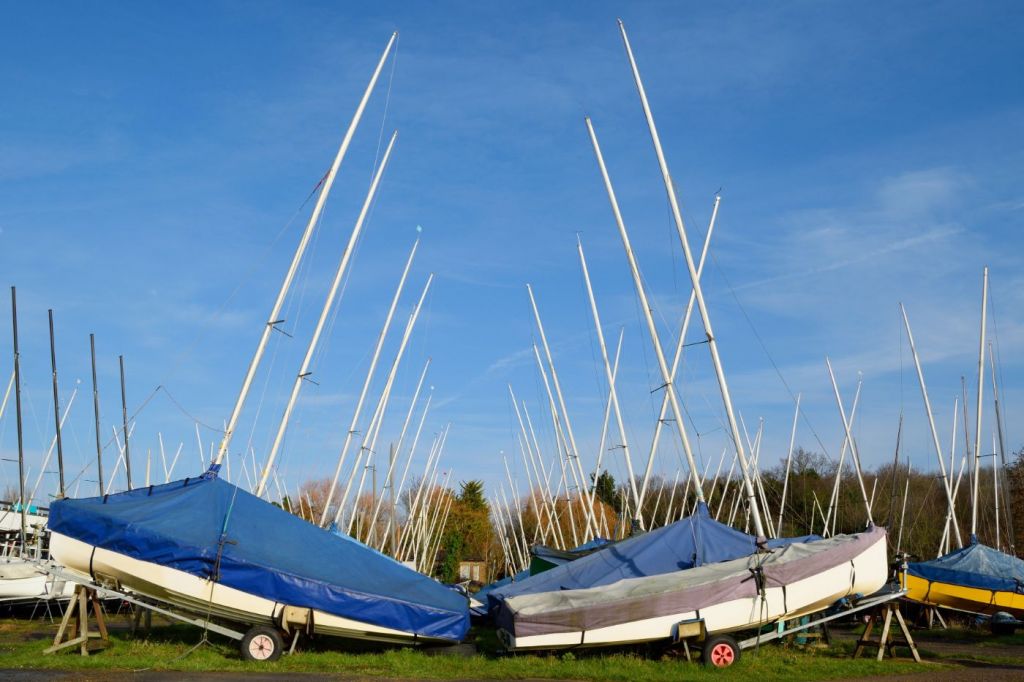
On this page:
How much does it cost to store a boat, traditional indoor storage, heated indoor storage, shrink wrapping, boat covers, open yard storage, dry stack storage, in-water storage, diy storage.
For traditional indoor storage, you can expect to pay between $50 and $250 per month on average. This cost can increase, reaching up to $200 per foot for a season in more expensive areas, depending on the level of protection and services provided by the facility.
The average cost for traditional indoor storage ranges from $50 to $200 per foot of boat for a season, depending on location and other factors. Some facilities offer discounts for long-term storage contracts or if you pay for the entire season upfront. To estimate your annual cost, measure your boat's length and multiply it by the per-foot rate. Be sure to account for any fluctuations in prices throughout the year and potential discounts when calculating your total expense.
Heated indoor storage is typically more expensive due to the additional energy required to maintain a suitable temperature, especially during colder months. Prices will be on the higher end of the range, but you'll have peace of mind knowing your boat is safe from freezing temperatures and potential damage.
While the exact prices can vary, heated indoor storage generally costs around $10 to $20 per ft per month, although it can range from $5 to $50 per ft per month in some cases. As an example, let's say you have a 25-foot boat, and the storage facility charges $15 per ft per month:
- Monthly cost: 25 ft x $15/ft = $375
- Yearly cost: $375 x 12 months = $4,500

This option is effective at protecting your boat from weather elements and typically costs between $10 to $15 per foot, depending on the boat's size and additional features, such as outboard motors and arches. It's a one-time investment each season.
Shrink wrapping is an efficient way to protect your boat during the offseason. In this option, a heavy-duty plastic film is applied over your boat and heated to create a tight-fitting, weather-resistant cover.
Is shrink wrapping worth it? What are its pros and cons? Find out here.
When considering shrink wrapping, here are several factors that affect the cost:
- Boat size : The bigger the boat, the more material needed and the higher the cost.
- Type of boat : Sailboats with masts raised can cost up to $3 more per foot than motorboats.
- Additional features : Zipper doors, vents, and reinforcement may increase the cost.
On average, boat shrink wrapping costs around $12 to $25 per foot , with additional expenses for added features.
Depending on the size and type of boat, annual shrink wrapping costs may vary:
- For a 20-foot boat, you can expect to pay between $200 and $300.
- Larger boats may have costs up to $1,000 or more.
The annual cost of shrink wrapping is usually lower than purchasing a permanent boat cover. Also, consider the convenience of accessing your boat during storage if you opt for zipper doors or vents.

Using a boat cover is a more affordable route, with prices ranging from $100 to $800 for a high-quality cover . It's essential to select a cover made from durable materials to withstand harsh weather conditions and provide adequate protection for your vessel.
There are a variety of covers available in the market, each offering different levels of protection based on factors like material, size, and the specific type of boat. In this section, we will discuss the factors affecting the price of boat covers and the annual storage costs you might incur.
When it comes to boat covers, a few factors can influence the overall cost. These factors include:
- Type of material : The material of the cover plays a significant role in both durability and protection. Some common materials for boat covers are canvas, polyester, and polypropylene. The cost of the cover will vary based on the chosen material.
- Size of your boat : The size of your boat directly affects the cost of the cover, as larger boats will require more substantial covers, leading to higher prices.
- Custom vs. universal fit : Custom-fit covers are designed specifically for your boat's make and model, providing a better fit and protection. However, they are generally more expensive than universal-fit covers, which are designed to fit a range of boat sizes and styles.
When calculating the annual storage costs of using a boat cover, consider not only the initial cost of the cover but also any additional expenses related to maintenance and replacement. Here are some estimates:
- The cost of a boat cover can range from $50 to $1,000, depending on the factors mentioned above.
- Shrink wrapping, which can offer better protection and last for 6-12 months, costs around $15-$28 for a basic installation.
- Maintenance costs, such as cleaning and repairing the cover, can vary. However, regular maintenance will prolong the life of your cover and prevent more significant expenses in the long run.
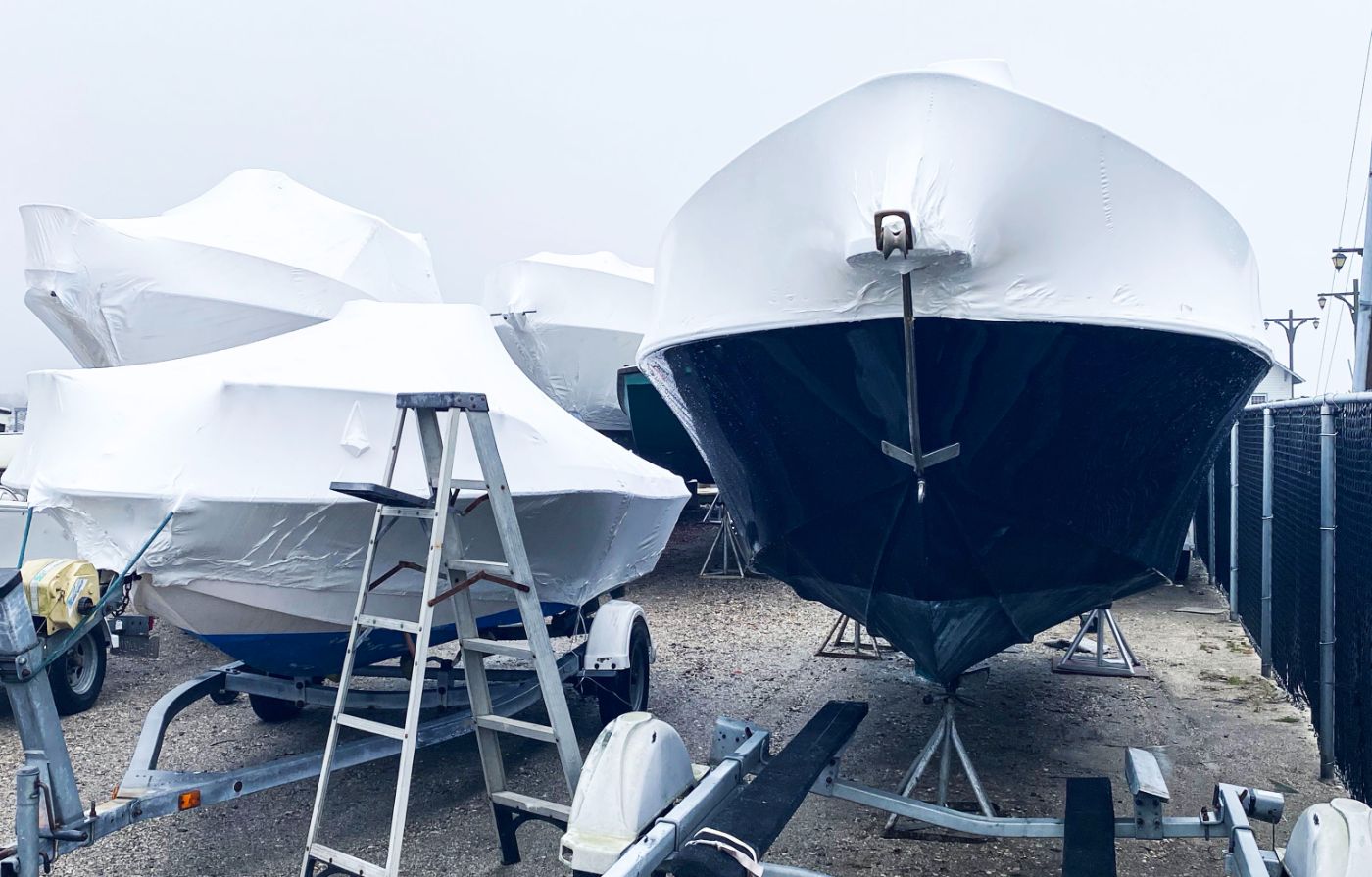
For an open yard or outdoor storage solution, you'll pay between $45 and $90 per month. Factors such as location, security, and access to amenities might cause prices to fluctuate.
Location plays a significant role in the cost of open yard storage. For example, storing your boat near popular water bodies or in high-demand areas will typically be more expensive than in less popular locations. Additionally, the cost may vary depending on the storage facility's amenities and additional services offered, such as 24-hour security or regular maintenance.
Boat size is also an essential factor in determining storage cost, as larger boats will require more space and may result in higher fees. Some facilities may charge per foot, with prices starting at $4 and going up to $7 per foot, per month.
Let's consider a rough example to provide an estimate for the yearly storage cost. Assuming you have a 30-foot boat and are storing it in an open yard facility with monthly costs of $5 per foot, your monthly storage charge would be 30 ft x $5 = $150/month. Therefore, the total yearly storage cost would be $150/month x 12 months = $1,800.
This is just an estimate, and actual costs may differ based on the specific situation and factors affecting the storage facility's fees. You may also benefit from exploring seasonal or long-term storage discounts, which some facilities may offer to reduce your overall storage expenses.
Dry stack boat storage is popular among smaller boat owners as the prices vary from $5 to $30 per ft per month. The convenience of easy access, better boat protection, and minimal water exposure make this a valuable option.
The average cost of dry stack storage varies depending on these mentioned factors, but to give you a general idea, monthly pricing can range from $20 to $26 per foot. Of course, prices may increase for bigger boats or if you require additional services such as concierge service, boat wash, engine flush, and prestocking your boat.
To help you with your budget, here's a quick breakdown of the costs you can expect for dry stack storage:
- Small boats : For boats under 20 feet, you can expect to pay between $400 and $520 per month.
- Medium boats : Boats between 20 to 30 feet may cost you approximately $600 to $780 per month.
- Large boats : For boats over 30 feet, be ready to spend from $900 up to $1,170 per month or more.
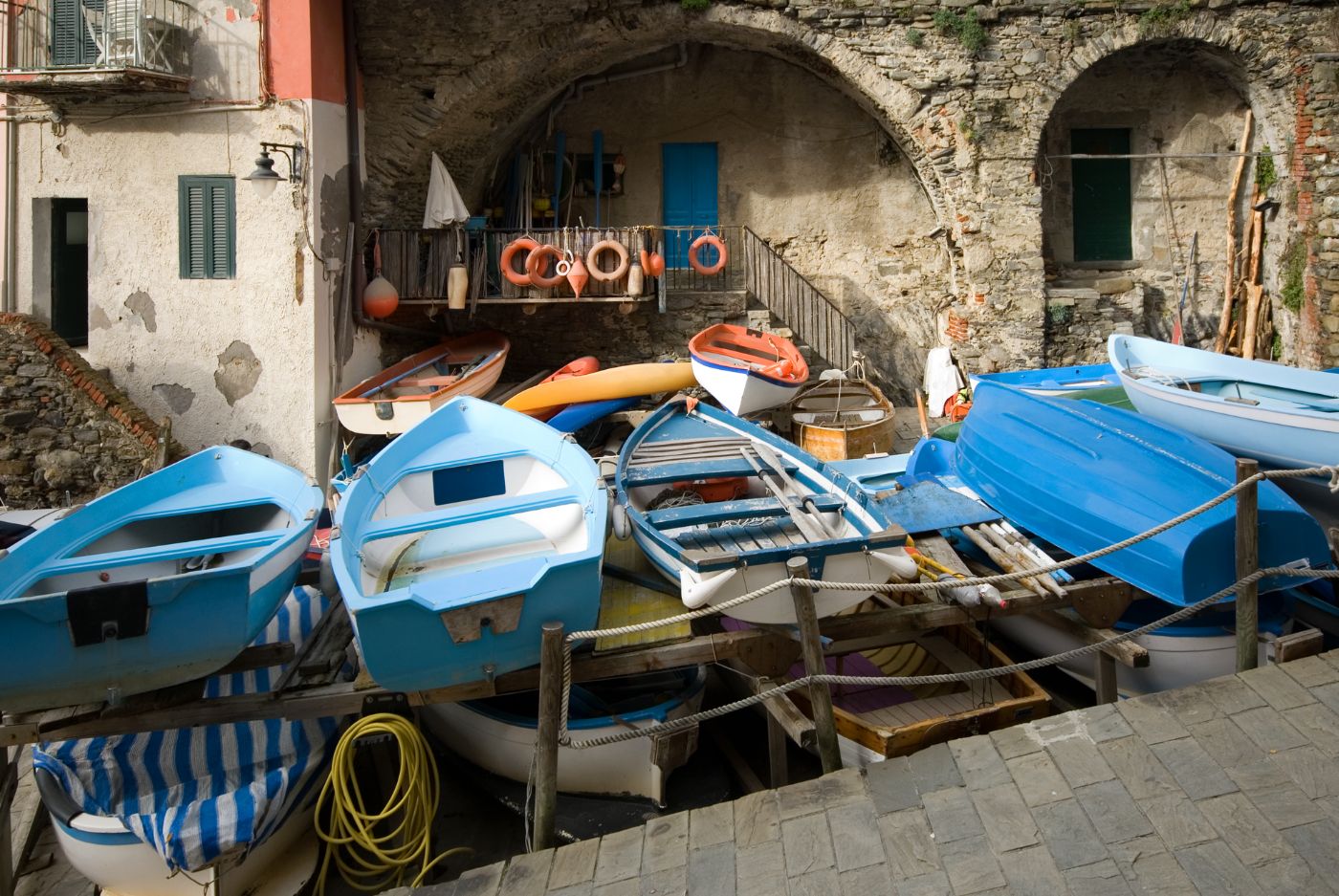
In-water storage, or marina slip rental, can cost between $10 to $30 per ft per month. Location, season, and length of stay can impact the total expense, but it's a practical solution for those looking for easy access to the water.
In-water storage is a convenient option for boat owners who wish to keep their boats easily accessible year-round. However, the costs for in-water storage can vary greatly depending on a few key factors:
- Location : The marina's location plays a significant role in determining the price you'll pay for in-water storage. In more popular or touristy areas, you can expect to pay a premium for a slip.
- Size of your boat : The larger your boat, the more it will cost to store it in the water. Marinas usually charge based on the boat's length; the longer the boat, the higher the fee.
- Amenities : Marinas may offer various amenities such as water, electricity, and gated access. The more amenities available, the higher the overall cost of in-water storage.
In-water storage costs can range widely depending on the factors mentioned above. On average, you can expect to pay around $10 to $20 per foot per month for in-water storage. These costs can add up significantly over the course of a year. For example, if you have a 30-foot boat and are paying $15 per foot per month, you can expect to pay $5,400 annually for in-water storage.
If you're planning to store your boat in a marina in the UK , here's our detailed article about the mooring fees there.
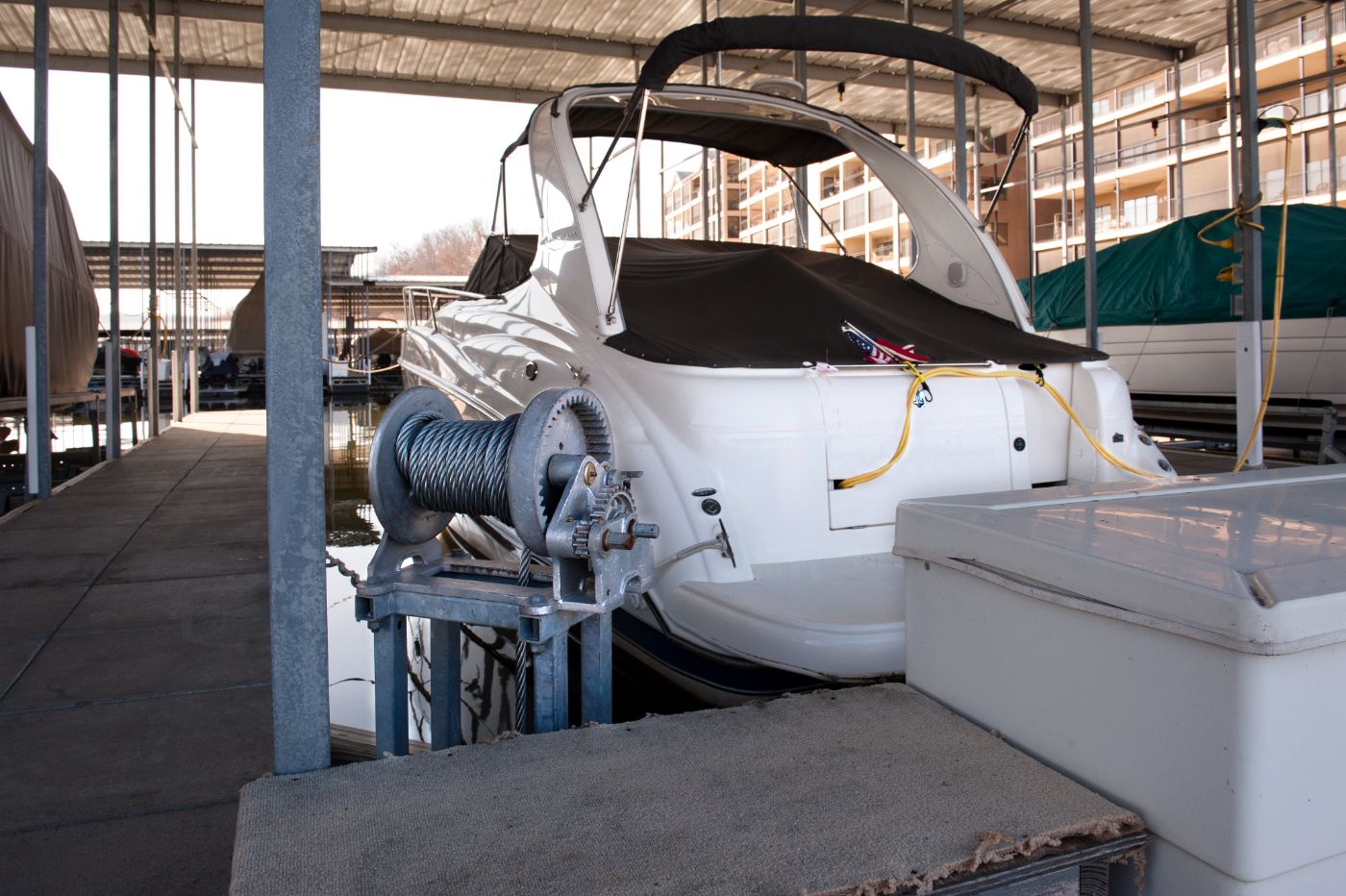
Lastly, DIY storage options, such as storing your boat at home on a trailer, depend on your available space and local regulations. This method helps save on storage fees but may require additional investments in security and maintenance equipment. Research your local area's rules and regulations first.
When choosing DIY storage for your boat, a friendly reminder to consider the following elements that could determine the overall cost:
- Space availability : You will need to have enough space available on your property to store the boat, whether it's indoor or outdoor storage.
- Local regulations : Make sure to check and comply with any local regulations and homeowners association rules that may apply to boat storage on your property.
- Preparation and maintenance : Depending on the storage chosen, there might be some preparation and ongoing maintenance tasks such as cleaning, dehumidifying, or checking for pests.
- Security and insurance : Ensure the safety of your boat by investing in proper security measures and updating your insurance policy accordingly.
Here's a rough estimate of the expenses for DIY storage:
- Indoor storage (garage or shed) : Depending on the size of your boat and the available space, this could range from free (if you have existing space) to several thousand dollars (if you need to construct a storage space).
- Outdoor storage (driveway or yard) : In addition to accounting for available space, you may incur some costs for materials such as tarpaulins or supports to properly cover and secure the boat. The price might range from $50 to $300 for covers and supports.
- Additional expenses : If needed, you might need to purchase a boat trailer for easier transportation and storage, ranging from $1,000 to $5,000 depending on the size and quality of the trailer. Additionally, consider any local fees or permits that may be required.
Leave a comment
You may also like, boat storage costs explained (for 50+ locations).
Boat storage costs can vary greatly depending on location, type of storage, and the size of your boat. For example, storing your boat in a popular, high-demand …

How Much Does It Cost To Dry Dock a Boat Exactly? (3 Types)

How Long Does it Take to Winterize a Boat on Average?

How Much Is It to Dock a Boat in the UK? (5 Boat Types)

What Are the Cheapest Mooring Fees in the UK? (& Where)
Own your first boat within a year on any budget.
A sailboat doesn't have to be expensive if you know what you're doing. If you want to learn how to make your sailing dream reality within a year, leave your email and I'll send you free updates . I don't like spam - I will only send helpful content.
Ready to Own Your First Boat?
Just tell us the best email address to send your tips to:
- OUR COMPANY
- VEHICLE GRAPHICS WARRANTY
- AFTERCARE INSTRUCTIONS
- CAREER OPPORTUNITY
- SIGNAGE CLIENTS
- Boat Wrapping Price Guide
How Much Does It Cost To Wrap A Boat?
Vinyl boat wraps offer an amazingly cost effective way to market a commercial brand with stunning visual colour imagery. With a Sealy Signs vinyl boat wrap, your boat will command attention both on the water and when it’s being towed on the road.
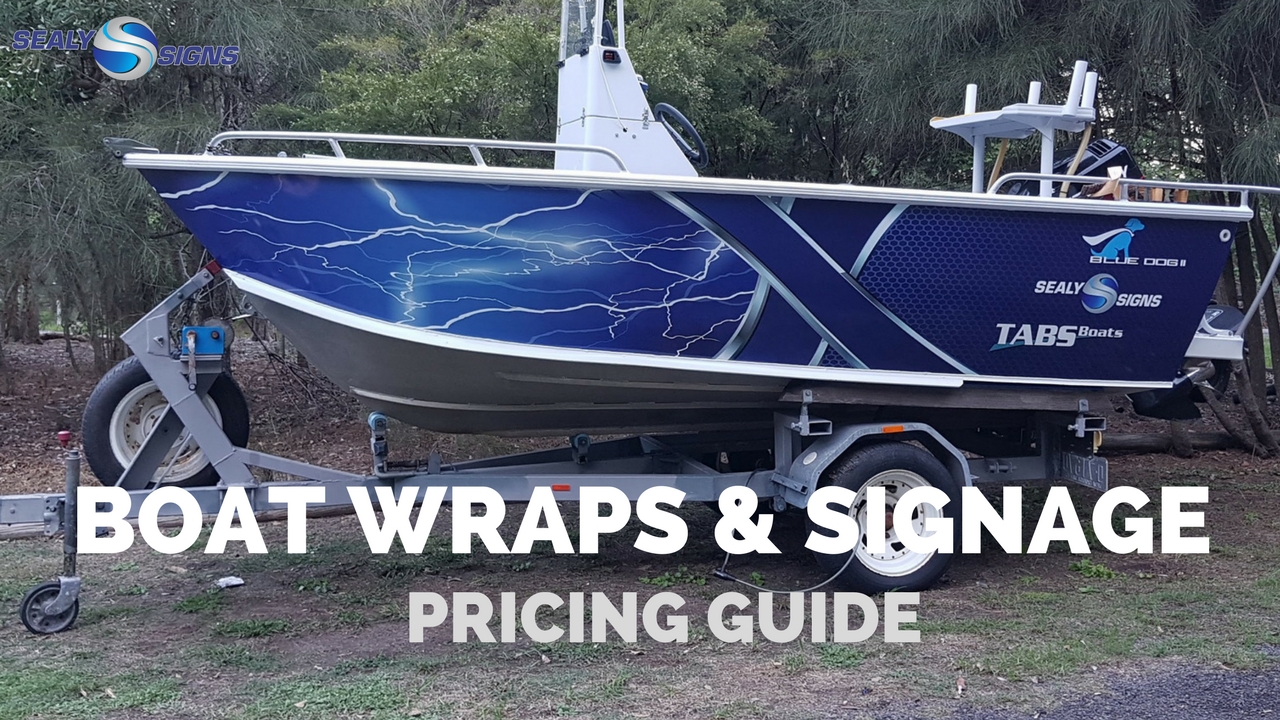
Research indicates that high quality company graphics on a boat will be viewed 100’s or 1,000’s of times each day. Boat wrap advertising is more effective and offers better value per impression than any other form of advertising.
The potential of boat wrap branding is enormous and your product or service doesn’t even have to be marine related – just think of Red Bull as one example.
Boat wraps are also an inexpensive way to make your new boat look stunning or to restore an older boat and enhance its resale value. Boat wraps are cheaper and more environmentally friendly than toxic marine paints.
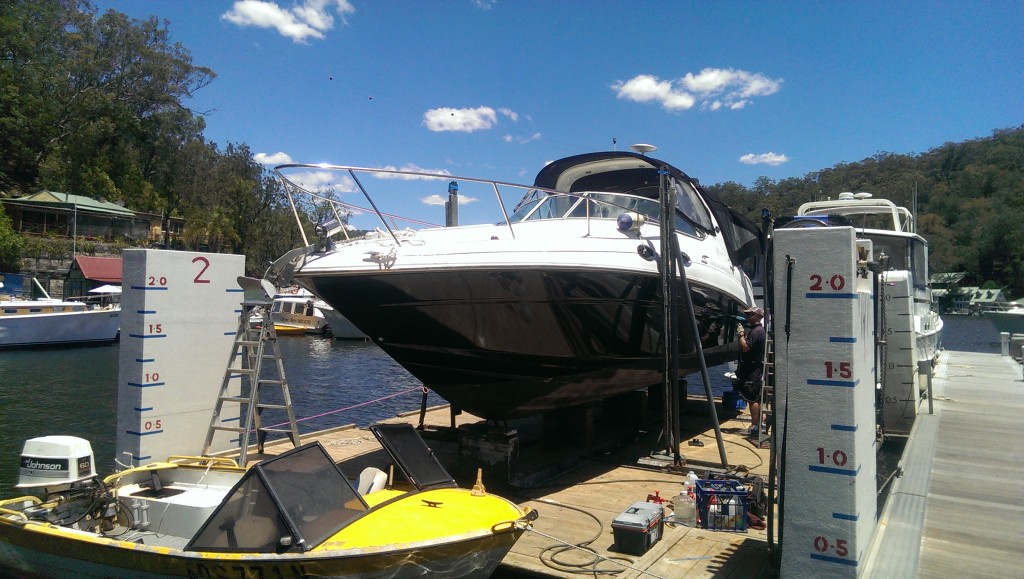
So how much does it cost to wrap a boat?
Of course, the size of the boat and how much of it you want wrapped play a large part in the cost.
We offer quarter, half, and full boat wraps as well as spot graphics but the final price will also be determined by the shape of the hull, the difficulty of installation, and the amount of graphics design work required.
Special finishes such as chrome or carbon also add to the cost.
Boat Wrap Price Guide
Here are some general price guides for trailer boats, these prices are for colour change wraps (using Avery supreme wrap), for custom printed or multiple colour wraps please inquire for custom pricing:
Below are approximate prices for a single colour wrap (using Avery supreme wrap) for larger boats:
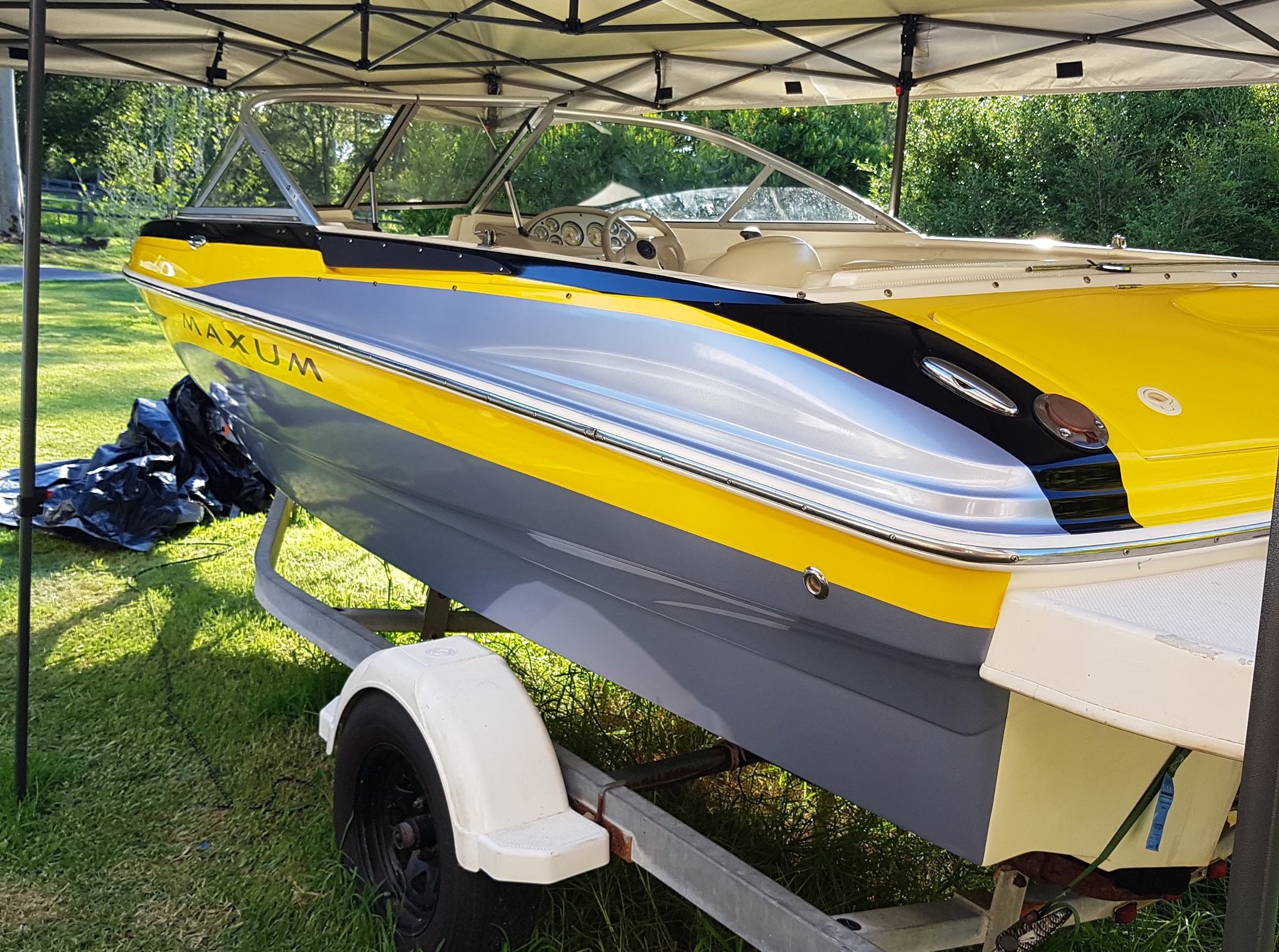
For boats longer than 45ft please contact us for a quote.
The above prices are based on flat plate sides from the waterline to the gunwale with no fixings.
Older boats may need preparation work such as cleaning, removing flaky paint, filling or removal of existing wraps or graphics.
We can do this for you at a very reasonable additional hourly rate. When requesting a quote please let us know if these services will be required.
Please inquire for an accurate quote to suit your boat’s make and model or to obtain custom pricing for cabin and above gunwale wrap.
Simply email us some photos of your boat and let us know how large an area you want wrapped and we’ll get back to you really promptly.

Vinyl Boat Wraps
Our vinyl wraps are not restricted to trucks, we also do vehicles, motorbikes, utes, vans, cars, buses, trucks / marine crafts & horse floats
All wrap vinyls are made for marine conditions to withstand salt UV and petroleum.
We offer In house design and professional installation (qualified Avery Installer) so you can be assured your graphics will last.

IMAGES
VIDEO
COMMENTS
The cost of shrink wrapping a boat will vary based on the length and dimensions of the boat. Even when two boats have similar lengths, it is still likely that the total cost of shrink-wrapping would differ for each. On average, boat shrink wrap cost per foot will be around $8 to $25. The type of boat you have will also affect prices, with an ...
So what is the average cost to shrink wrap a boat per foot? For powerboats, it will cost between $12 - $25 per foot on average. For sailboats, it will cost between $12 - $25 per foot on average. For sailboats, expect a $2 - $3 dollar price increase if you leave the mast up.
Size of the Boat. The primary cost factor I consider when shrink wrapping a boat is the size of the boat. Generally, the boat shrink wrap cost per foot ranges from $8 to $25. Bigger boats need more material and time, which leads to higher costs. Example: a 20-foot-long boat would cost between $160 and $500.
Shrink wrapping involves a lot of different pieces, not least of all the propane-fired heat gun necessary for providing the temperatures that make the polyethylene shrink to cling tightly to the boat. Some starter kits can easily cost $600 to $1200, though it's also possible to rent the gun for a week. Aside from the cost of getting the ...
Cost of Shrink Wrapping. Costs of shrink wrapping will vary greatly depending on the size and type of boat and its location. Average costs range from $8 to $25 (or more) per foot. Additional costs may apply for special configurations or installation of hatches and vents.
Cut two slits in the plastic where it will wrap around the mast or the wooden frame. Then, use tape to secure and watertight seal the plastic to the mast. Do this with both halves of the plastic cover. Make cuts in the plastic for the stays and secure the plastic with more tape.
The cost of shrink wrapping a boat can vary depending on the size of the boat, the type of boat, and the location of the service provider. In this section, we will compare the pricing models of the top 5 boat shrink wrap service providers to help you make an informed decision.
The cost of shrink wrapping a 20-foot boat ranges from $200 to $300, while a high-quality tarp can cost as little as $50. However, it is important to note that shrink wrap is a more long-lasting option, which can ultimately save boat owners money in the long run.
The cost of shrink wrapping a boat will vary based on the length and dimensions of the boat. For powerboats, it will cost between $12 - $25 per foot on average. For sailboats, it will cost between $12 - $25 per foot on average. For sailboats, expect a $2 - $3 dollar price increase if you leave the mast up.
Over time, shrink wrapping your boat every year will cost more than buying a custom cover. While the initial cost of a permanent cover is high, you won't be spending any money to cover your boat for the next decade. The average cost of a permanent cover will be much lower over the life of the cover. You probably should hire pros.
You can also give us a call at 1-800-847-5290 to ask about the range of costs to shrinkwrap a boat or for general inquiries. Get a Quote for Your Project. First Name*. With competitive pricing, fast shipping, and experienced professionals, you can trust Mr. Shrinkwrap to shrink wrap your boat. Request a quote online today!
Regular Maintenance: Essential for extending the life of the wrap, including cleaning with proper solutions and techniques. Based on industry insights, the average lifespan of a boat wrap ranges from: 5-7 years, with standard materials and care. Up to 10-15 years, for premium quality wraps that are well-maintained.
Shrink wrap is a polyethylene which has UV inhibitors, and is formulated to shrink when heated to create a seal which is much tighter than the one you or I can make with a tarp and ropes. That seal not only keeps the weather out of your boat, it also prevents the stretching and tearing tarps commonly display after a few months in the elements.
Having your boat encased in shrink wrap for the winter isn't cheap. Professional boat shrink wrappers use the boat's size to determine the final amount. When you have the boat covered by a professional, you should plan on spending $12-25 per square foot. You can save a little money if you do the work yourself. Related.
In addition to the base cost of shrink wrapping a boat, there are also optional accessories and add-ons that can increase the overall cost. Anti-moisture bags, for example, can cost around $8 each. Adding an entrance to the shrink wrap can cost between $30 and $40.
You can also call us at 1-800-418-1230 for a boat shrink wrapping quote or with any questions. Shrink Wrapping for International Shipping. Shrink Wrap. We can wrap your boat wherever it is. We will come to you. We can wrap before we haul them as well. Please call us to discuss your shrink wrap needs.
Generally, a full wrap can cost anywhere from $1,500 to $15,000 or more, depending on your boat's size and type. On the other hand, if you're up for a challenge and confident in your abilities, you can attempt a DIY boat wrap. In this case, the cost of materials alone falls around $7-$10 per square foot.
On average, the cost of shrink wrapping a boat can range from $8 to $15 per foot of boat length. For example, a 20-foot boat may cost $160 to $300 to shrink wrap, while a 30-foot boat may cost $240 to $450. However, prices may go up if additional services are requested, such as the removal of seats, covers, or other fixtures.
The tape is used to seal seams, reinforce edges, and ensure that the shrink wrap remains securely in place. When choosing tape for shrink wrapping, opt for a strong, weather-resistant option that will adhere well to both the shrink wrap film and the boat's surface. Recommended tapes for shrink wrapping: 3M Scotch Heavy Duty Packaging Tape
The cost of shrink wrapping a boat can vary depending on the size of the boat and the location of the boatyard. In general, the cost ranges from $12 to $25 per foot. Small Boats (20-30 feet) For small boats, the cost of shrink wrapping is on the lower end of the scale. On average, it can cost between $12 to $15 per foot.
1.3 When It Doesn't Make Sense to Shrink Wrap Your Own Boat. 2. DIY Shrink-Wrapping Tips. 2.1 Practice First! 2.2 Use a Section of Rope To Figure Out How Wide to Order your Wrap. 2.3 Make Sure your Boat Is as Dry as Possible Before Wrapping. 2.4 Don't Wrap Over Marine Paint. 3.
Additional features: Zipper doors, vents, and reinforcement may increase the cost. On average, boat shrink wrapping costs around $12 to $25 per foot, with additional expenses for added features. Depending on the size and type of boat, annual shrink wrapping costs may vary: For a 20-foot boat, you can expect to pay between $200 and $300. Larger ...
20 - 24 foot. No Higher than 700mm. $1,200. 20 - 24 foot. Higher than 700mm. $1,400. Below are approximate prices for a single colour wrap (using Avery supreme wrap) for larger boats: Boat Length. Side Height.